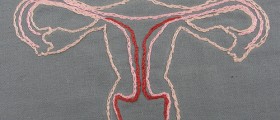
Functional cysts, the kind of cysts that can get as large as 3 to 4 inches (7.5 to 10 cm) in diameter, usually drain themselves in just 3 or 4 weeks. The difference between polycystic ovaries and PCOS lies in how extensive their symptoms are. A diagnosis of polycystic ovaries simply requires an ultrasound exam finding multiple cysts.
For a woman to have polycystic ovarian syndrome, or PCOS, she must exhibit two of the following symptoms:
1. Polycystic ovaries.
2. Failure to ovulate on a regular basis, failure to ovulate at all, or unusual timing of or absence of menstrual periods, resulting in infertility.
3. Masculinizing features, such as unusual hair growth or acne, caused by excessive syndrome.
Some authorities add breast discharge to this list, still requiring just two symptoms our of four for a diagnosis of PCOS. While polycystic ovaries are not associated with imbalances of testosterone, luteinizing hormone (LH), and follicle stimulating hormone (FSH) found in PCOS, they may be associated with other endocrine disturbances. Many women who have polycystic ovaries but not PCOS suffer either hypothyroidism or Cushing's syndrome. Cushing's syndrome is a condition in which the body makes too many stress hormones. This can be due to a lesion in the pituitary gland in the brain, but more likely it is due to steroid medications or some stress on the liver that keeps it from recycling naturally occurring stress hormones. Over the long run, treating stress relieves polycystic ovaries in women who do not have PCOS.















_f_280x120.jpg)

Your thoughts on this
Loading...